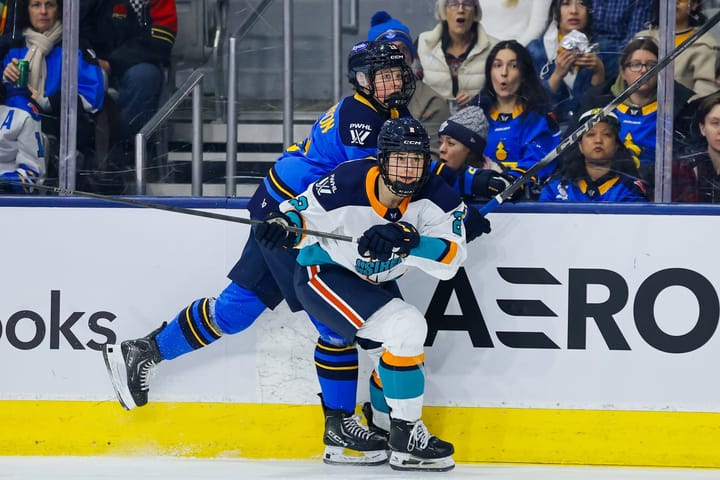The legal reality of #OneLeague
While it appeared both sides were ready for some form of #OneLeague, their legal structures could have made it difficult - if not impossible.
Editor’s note: This article was conceived, researched, and written before the CWHL announced its dissolution on March 31, 2019. Edits have been made incorporating a discussion of this news.
It is also noted that the author of this article is American, with working knowledge of corporate structures in the United States. It is possible that, in writing this article, some of the nuance regarding the corporate structures in Canada were missed or misstated. If so, corrections will be made accordingly. This article does not purport to provide legal advice to any individual or entity and does not represent the views of the author’s employer.
Why was a simple #OneLeague merger with the NWHL and CWHL always a pipe dream?
Besides each league commissioner’s view on how the NHL should be involved and the valuation provided by Gary Bettman, there were legal hurdles that would’ve made the merger extremely difficult, if not virtually impossible.
It is important to understand the differences between the NWHL and the CWHL as they stood with minimal NHL involvement. Because although they had the same end goal of advancing the women’s game, their respective approaches were legally extremely different - and that may be what held things up.
Structure
It is well known that the NHL and its spokespeople have repeatedly said it doesn’t believe in either leagues’ business model. But what does that phrase mean? Something different depending on which side of the border you’re on.
The Canadian Women’s Hockey League was operated by the Canadian Association for the Advancement of Amateur Women’s Hockey – a not for profit, tax-exempt organization operating as a Registered Canadian Amateur Athletic Association (RCAAA). The requirements for registering and maintaining registration as an RCAAA are fairly stringent. The most important of these requirements is that it devotes its resources to the purpose of promoting amateur athletics in Canada.
There are numerous considered to determine whether an organization’s exclusive purpose is the promotion of amateur athletics, including:
- regulate a sport and the way it is played
- promote a sport
- oversee a structure of local clubs, and regional, provincial, and territorial bodies involved in a sport
- deliver a training program that brings promising athletes from the grassroots level to national and international levels through various qualifying competitions
- manage a national team to participate at international competitions
- stage and sanction local, regional, provincial, territorial, and national competitions
- act as a Canadian representative of an international federation controlling a sport
- provide a training and certification program for coaches and referees
- carry out fundraising activities and redistribute funds for local, regional, provincial, and territorial member organization/
The neatest category that the CWHL fits into here is the regulation of the sport and the way it is played. But perhaps the stickiest requirement of RCAAA registration is that these registered amateur sports organizations must serve a nation-wide purpose. Therefore, a team solely based and owned in Ontario or Quebec or Manitoba may not be able to receive RCAAA status because it would be considered “of a local, regional, provincial, or territorial character.”
As far as we can tell based on available data, the teams in CWHL were not privately owned. They were owned and operated by the Board of Directors and the Commissioner’s office. The question arises, then, was the CWHL able to sell teams to interested private owners and maintain its RCAAA status? Does having teams owned by entities outside of the commissioner’s office, in different provinces, create an issue regarding the “nation-wide” requirement of the RCAAA?
Aside from that potential issue, you would be hard pressed to find an investor whose desire to “grow the game” doesn’t also bring a desire for economic advantage. And while it’s not uncommon for non-profits to make money (à la the NCAA), RCAAAs receive fairly intense scrutiny from the Canadian government, particularly when their financial activity resembles that of a tax shelter. For example, Canadian Little League Baseball, Football Canada, Biathalon Canada, and the Canadian Lacrosse League have all had their RCAAA statuses revoked since 2010 for, among other things, issuing “donation receipts for abusive transactions as a participant in tax shelter arrangements that… do not qualify as gifts.”
While the phrase “tax shelter” has a bad connotation, there are legal ways to reduce income taxes on business investments without being considered “abusive.” This is a fine line to toe. It is possible that the CWHL wasn’t able to find investors for individual teams willing to toe that line, considering the heightened scrutiny RCAAAs have come under in the last decade. This didn’t stop them from partnering with individual NHL teams - like the Montreal Canadiens, Calgary Flames, and Toronto Maple Leafs.
It is noted that in addition to being hard to privatize, an RCAAA would need to dissolve completely in order to re-incorporate as a private, for-profit corporation.
Conversely, the business side of the NWHL operates as “NWHL LLC” or “NWHL Holdings LLC.” A limited liability corporation (LLC) is the most common type of business organization in the United States. They provide the easiest setup and most flexible ownership to small businesses, and are often a good jumping off point for a start-up. As its name implies, an LLC limits the liability of the corporation – extending it only to the money invested by its members. Anyone can be a member of an LLC, but members are usually the company founders and early investors, who trade the capital to get the business started for some control of the new business. If the LLC becomes insolvent or defaults on a contract, the members of the LLC are only liable to the amount of money they put in, and nothing beyond. This is an attractive option for start-up businesses starting out and in fairly fickle or volatile markets, like women’s hockey. It also provides flexible tax options, as the LLC can chose to either be taxed as a partnership or as a corporation.
An LLC is often a jumping off point for start-ups. As the business gains investors and capital, LLCs will often incorporate or sell to a corporation. Most LLCs are small businesses getting their sea legs and gaining stability before selling off. In fact, it is not an uncommon business practice for many LLCs to run at a deficit for the purpose with the intention of being purchased by a larger corporation. They are the ideal business model for investors who want financial protection in the event of a default and want to have an active role in management.
The LLC is a very small, personal business model that requires communication between parties and a general cooperation for its sustainability. There are often growing pains and disgruntled investors, especially in ambitious ventures. But they are not usually national news.
In its first four years, the NWHL and Commissioner Dani Rylan have been accused of everything from missing payments to defrauding investors to paying a coach under the table and violating immigration laws. Rylan was sued by former Chief Marketing Officer Mike Moran for breach of contract – citing a lack of transparency in how much Moran was entitled to as an investor in the league. There was a mass exodus of the old guard USA Hockey players (e.g. Knight, Bellamy, Decker) presumably because of massive, surprise salary cuts. Only one team, the newest, has turned a profit.
But they’ve also had an influx of young national team players looking to play close to home and a team purchased by Pegula Sports, the ownership body of the Sabres - the first full private ownership group in the league. They’ve formed strategic partnerships with the Boston Bruins, New Jersey Devils, and Minnesota Wild. They’ve had sell out, out of market games for several years. While these victories don’t necessarily cancel out millions of dollars of lawsuits and alleged organized smear campaigns by former executives, they certainly help with the credibility of the league.
Start-ups and LLCs usually have a few months or even years to get situated and adjust to growing pains before receiving international scrutiny. Unfortunately, sports leagues cannot survive if they follow that route. Capital is gained through attention, through butts in seats, so it is imperative to have your ducks in a row before opening the doors to the general public. The NWHL did not do that, and so the traditional business plan of gaining capital and investors and then incorporating has become much, much more difficult.
#OneLeague
It is a simple, clear fact that the status quo in North American women’s hockey is not sustainable. This was further emphasized by the CWHL’s shuttering on March 31. One league was run as a non-profit out of the commissioner’s office, and folded with no impetus for parity besides its athletes’ competitiveness. The other is for-profit, but in its short tenure has been mired in controversy with investors and directors. Conversations about becoming one league had allegedly started behind the scenes, and were even supposed to continue in April, but from the outside it looks like one league was looking for a buyout from the NHL and the other wants to continue to exist independently.
And then there’s Gary Bettman.
Bettman has repeatedly said in no uncertain terms that he does not believe in the business model of either women’s league. This statement is understandable, because the models of both leagues are meant for small scale businesses. One requires maintenance of a semblance of amateurism, one is best made for start-ups and low-capital businesses looking to grow.
Investment in women’s hockey is not a goodwill venture. It is a strategic choice that must be lucrative to Bettman, team ownership, and inevitably, unionized players in order to be worthwhile.
As a result, the NHL does not want to invest in either women’s league. It wants to create its own league, run it in its own way. Bettman advised that he believes the talent pool is 6 to 8 teams deep, and the league is not interested in entering a crowded market. He has said that the NHL is willing to wait for both leagues to leave the market, or fold, to throw its hat in the ring. His vision for women’s hockey in America does not appear to include a buyout of either league or paying off any of the parties with an ownership interest in the leagues to use their names, logos, etc.
It appears that Bettman and the NHL understand that they hold all the cards. At the moment, the NHL is standing on a cruise ship while ownership of the NWHL and the CWHL fight over a single oar in a life raft. The NHL is financially stable, and a well-known brand with markets in two countries. It certainly does not have to invest in the women’s game, especially if the women’s game is going to take a few years to be lucrative. So it can wait until the raft sinks.
So where does that leave the NWHL, CWHL, and #OneLeague?
Hayley Wickenheiser and Cassie Campbell-Pascal hinted that the CWHL was willing to go along with the NHL’s plan, which presumably meant fold, and the NWHL is standing in the way of that reality. There is no indication that the CWHL’s dissolution was part of an effort to hand the reins to the NHL.
Considered contextually, it makes sense that the NWHL has opted not to cede contol to the NHL commissioner’s office. The NWHL has replicated the NWSL/MLS model in one city so far, where the ownership of the Buffalo Sabres purchased (and seriously upgraded) the Buffalo Beauts. They have interest and working relationships with three other NHL teams, and if those relationships prove lucrative for ownership, they could lead to further investment. From the outside, it seems the first few years of front office growing pains are behind them.
The CWHL ran the same way for over a decade, without these fiscal relationships, and it is possible they believed the only way to advance the game was to fold and let the NHL take over. It is also possible that shifting from a nonprofit to a private company takes time, money, and resources the CWHL simply did not have, and as a result, its new ownership opted to shutter the operation entirely.





Comments ()